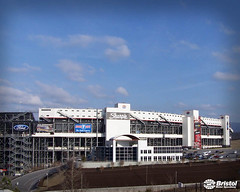 Image by Bristol Motor Speedway & Dragway via Flickr
Image by Bristol Motor Speedway & Dragway via FlickrNASCAR ran their first race at Bristol on July 30, 1961. Jack Smith was the winner of the first race, but Johnny Allen took the checkered flag driving in relief of Smith.
In 1969 they decided to make it a bit more intense. The track was reshaped and reconfigured. It increased in length to 0.533-mile, which made it slightly egg-shaped, and the banking was steeped even higher, now 36 degrees. Daytona and Talladega style banking on a little short track.
Over the years, more and more seats have been erected around the little bowl. By 1996, seating had increased to 86,000. That was also the year the name was changed to Bristol Motor Speedway (slogan: "racin' the way it ought'a be!"). Now 160,000 seats surround the tiny bowl.
Immediately after the 2007 spring race, repaving work began at BMS. Progressive banking was added -- this means that the banking changes, getting steeper as you go higher up the track. It's now 24 to 30 degrees in the corners and 6 to 10 degrees in the straightaways. Darrell Waltrip, a three-time Cup champion and a Fox broadcaster, did a ceremonial groundbreaking (trackbreaking?) during the postrace programming. Work began in earnest the next morning and was completed in time for the fall races. That 2007 spring race also saw the debut of the Car of Tomorrow. Kyle Busch won the race and promptly proceed to trash the COT in Victory Lane interviews.
The progressive banking has improved the racing, but dampened the action that Bristol is known for. Before the change, there was really only one line around the track and the only way to pass someone was to knock them out of your way. With the progressive banking the drivers can run in two grooves all around the track -- a lot more side-by-side racing, a bit fewer wrecks.
Before the 2010 season, Bristol Motor Speedway extended the Steel and Foam Energy Reduction (SAFER) barriers 84 feet coming out of Turns Two and Four. The net effect is to make the track a little tighter. That seems to have been the goal, much more than anything to do with safety...
"What we're hearing from folks who aren't renewing their tickets, from the majority of them is, it's economically related, and there's not a lot we can do about that," said Kevin Triplett, Bristol's vice president for public affairs. "But we are hearing from a lot of folks who say, Bristol has been known to be tight, and you guys have given them so much room.
"There's an element out there that loves three- and four-wide racing, and there's an element out there that would love it to be a little bit tighter. So we looked at how we could do it keeping the element of safety in mind. We decided, well, we could extend the SAFER barriers. And adding SAFER barriers, we think, is always a good thing."
Many NASCAR drivers have a short-track background and do well at Bristol, but it's easy to get caught up in someone else's wreck with 43 cars crammed into a half-mile at speeds over 100 mph. Darrell Waltrip leads all drivers with 12 wins at Bristol, including seven in a row. Jeff Gordon and Kurt Busch lead all active drivers with five wins, but Busch hasn't won there since 2006 and Gordon since 2002. Kyle Busch and Carl Edwards have combined to win five of the last six Bristol races. Ryan Newman set the Sprint Cup qualifying record, a lap of 14.908 seconds (128.709 mph), in 2003.
Bristol Motor Speedway hosts a Sprint Cup race, the Food City 500, and a Nationwide race in March. In August, Bristol hosts a second Cup race, the Irwin Tools Night Race, and a Camping World Truck race. The big number after the race names refers to laps, not miles. The Sprint Cup races are 266.5 miles long.

Bristol Cup race winners
NASCAR tracks index

![Reblog this post [with Zemanta]](http://img.zemanta.com/reblog_e.png?x-id=a3503acb-095a-4f44-816c-3fbba7652d1e)
No comments:
Post a Comment